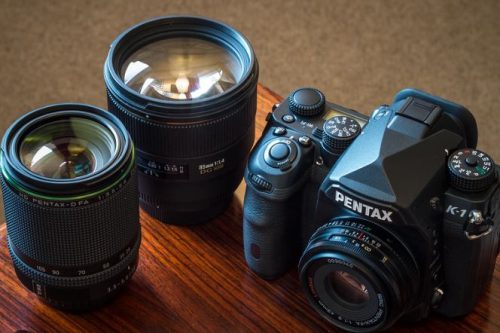If you are a dedicated Astro photographer, a quality camera to capture the best photos is an indispensable tool to have. The best astrophotography cameras for beginners are designed with ease of use in mind and are capable of capturing the night sky in phenomenal detail, surpassing the capabilities of any other lenses.
Whether you do astrophotography as a hobby or a profession, there are a myriad of lenses that you can use. However, the quality of pictures that astrophotography cameras provide is second to none. These cameras are capable of capturing high-resolution images rich in detail and stunning in color contrast.
What is an Astrophotography Camera?
An astrophotography camera is a special type of camera dedicated to capturing photos of faint objects in space at night. These cameras have sensors that are ultra-sensitive to low light and color filters for capturing different light wavelengths.
Just like traditional cameras, astrophotography cameras come in different types and your ultimate choice will depend on individual preferences and needs. The popular options available out there are dedicated astrophotography cameras, mirrorless cameras with astrophotography capabilities, and Digital Single-Lens Reflex (DSLRs).
Most astrophotography cameras have advanced software that facilitates rapid image acquisition, processing, and easy control of camera settings. They are also designed to be compatible with telescopes and other optical systems for added functionality.
Best Astrophotography Cameras for Beginners – Top Picks
Here are our top picks of the best astrophotography cameras for beginners. Let’s have a look.
#1) Pentax K-1 Mark II Full Frame 36 MP Weather Resistant DSLR – Best Overall
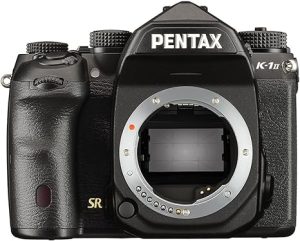
Pentax K-1 Mark II 36 MP Weather Resistant DSLR Camera is the best astrophotography cameras for beginners.
The selling point of this camera is its in-body shake reduction mechanism which is effective in eliminating all types of camera shake during use. Other than that, the camera has a flexible tilt-type LCD monitor that provides an innovative mechanism to tilt the monitor to any desired angle.
Another distinguished feature of this camera is its enhanced processing and improved imaging capability. Revolving around a 36.4MP CMOS sensor and Prime IV image processor, it produces high-resolution stills at up to 4.4 fps. It also has a Ricoh-developed accelerator unit which for practical reasons, increases color accuracy by boosting its sensitivity in low light.
To add to its distinct imaging assets, this camera is characterized by a unique physical design that comprises a stainless-steel and magnesium alloy body. It also has robust and extensive weather sealing that makes it suitable for use in harsh climates and cold weather.
Key Features
- Built-in Wi-Fi and GPS
- Pixel shift resolution II
- Full HD 1080p30 Video recording
- Prime IV image processor
- Magnesium alloy body
- Dependable dustproof and weather-sealed construction
- 2” cross-tilt LCD monitor
- In-body shake reduction mechanism
- Air gapless LCD monitor
Pros
- High build quality
- Excellent ergonomics
- Great features and value
- Easy to use
Cons
- Heavy
#2) Canon EOS R6 Full-Frame Mirrorless Camera – Best for the Money
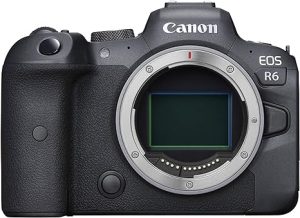
Canon is a brand with a great reputation in the industry of cameras. The EOS R6 Full-Frame Mirrorless Camera is one of their best models for astrophotography and has everything you need to keep up with this hobby.
It delivers outstanding image quality with a high-performance 20 MP CMOS image sensor. The enhanced image processor maximizes detail while reducing noise. Furthermore, the camera offers continuous high-speed shooting up to 12fps and has a fast, precise autofocus for added convenience.
When it comes to the body design, the camera incorporates four distinct control dials across the body. This enables fast and intuitive focus point selection and menu navigation. What’s more, the rear 3.0” 1.62m-dot LCD touchscreen has a Vari-angle design that benefits front-facing recording. It also makes the camera easy to use when working from high and low shooting angles.
The camera also has impressive durability. It has a sturdy, weather-sealed body to handle tough working conditions and inclement weather. Over and above that, it comes with dual storage card slots and 2.4 GHz Wi-Fi connectivity.
Key Features
- Sensor shift 5-axis image stabilization
- Dual SD UHS-II memory card slots
- DIGIC X image processor
- 20MP full-frame CMOS sensor
- Dual card slots
- Vari-angle LCD touchscreen
- Scroll wheel and controller stick
- Weather-sealed body
Pros
- High-speed continuous shooting
- Robust and reliable
- Wireless capabilities
- Fast, precise autofocus
Cons
- Big budget
#3) OM SYSTEM OLYMPUS OM-1 Micro Four Thirds System Camera – Best Compact
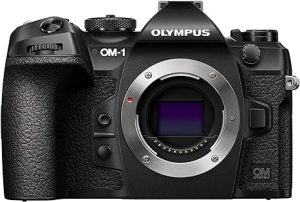
If you are looking for a compact, lightweight, and travel-friendly astrophotography camera, look no further than the OM SYSTEM OLYMPUS OM-1 camera. It is a micro four thirds system camera whose features are packed in a compact body for functional handling.
With the 20MP stacked sensor and TruePic X processor, the camera offers enhanced image quality and 3x faster processing speeds. The processor is also responsible for contributing to the wide ISO range and quick continuous shooting rates.
Another impressive thing about this camera is its image stability. It has an in-body 5-axis image stabilization which compensates for up to 8 stops of camera shake. Besides that, there are four creative shooting modes for you to choose from.
The durability of this camera makes it ideal for every adventure. It is made with a magnesium alloy body which is dustproof and splash-resistant. The tough design is also freezeproof-tested for reliable use in temperatures as low as 14℉.
Key Features
- Dual UHS-11 SD card slots
- High-res shot, Live ND, and Composite modes
- 20MP stacked BSI Live MOS MFT sensor
- Cross quad pixel phase-detection AF
- 76m-Dot OLED electronic viewfinder
- 5-axis in-body image stabilization
- Fast 120FPS EVF
- Durable shutter
- IP53 dustproof, splashproof, and freezeproof
Pros
- Outstanding durability
- Compact, lightweight, and travel-friendly
- Excellent image quality
Cons
- Stiff dials
#4) Sony Alpha 7 IV Full-Frame Mirrorless Camera -Best Image Quality
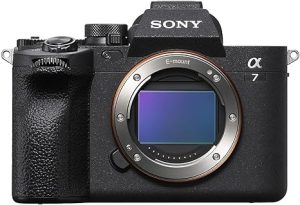
Sony Alpha 7 IV Full-Frame Mirrorless Camera marks our fourth pick of the best astrophotography cameras for beginners. It is an all-rounder camera that pushes beyond the basics with its hybrid design.
This camera is expensive but worth it. It employs a newly developed 33MP Exmor R BSI CMOS full-frame sensor that provides high clarity and vivid color rendering. The sensor coupled with the back-illuminated design makes the camera ideal for capturing images in low-light conditions.
Moreover, the high-speed image processing capabilities of this camera make it ideal for fast continuous shooting and advanced AF tracking performance. A unique solution to compensate for how the lenses perform is also included to ensure smooth focus transitions.
The other noteworthy features included are an advanced external flash control, built-in Wi-Fi connectivity, and a viewfinder that supports both standard 60fps and 120fps frame rates.
Key Features
- Creative looks and soft skin effect
- Focus breathing compensation
- 33MP full-frame Exmor R CMOS BSI sensor
- 759-Pt. Fast hybrid AD, real-time eye AF
- Vari-angle LCD touchscreen
- Wi-Fi connectivity
- AI-based autofocus
- Built-in viewfinder
- Multi-interface shoe
- Full-size HDMI A port
Pros
- Incredible image quality
- Ease of use
- Excellent ergonomics
- Versatile
Cons
- Pricey
#5) Nikon D5300 24.2 MP CMOS Digital SLR Camera – Best Budget
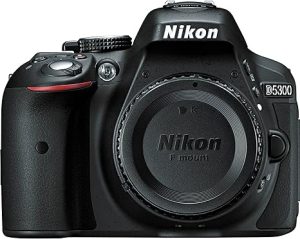
Nikon D5300 24.2 MP CMOS Digital SLR Camera marks our last pick of the best astrophotography cameras for beginners. It is reasonably affordable so you don’t have to spend a fortune to get your camera.
The dazzling image quality and detail in this camera meet modern connectivity via Wi-Fi for instant photo sharing. Furthermore, the camera has a remote control for added convenience and a built-in GPS with mapping for geotagging and easy tracking of your adventures.
This camera comes with a brilliant 3.2” swiveling Vari-angle display which delivers beautiful views from any angle. It is also compatible with a wide range of NIKKOR lenses to bring you unmatched levels of image quality and capabilities.
When it comes to construction, the camera is compact so you can carry it with you wherever you go. The lightweight design enables functional handling and with the ergonomic design, you are guaranteed efficient handling all through. It also has high-quality construction to withstand impacts and accidental falls.
Key Features
- Built-in GPS with mapping
- Wi-Fi connectivity
- 2-inch swiveling display
- 2 MP image sensor
- CMOS photo sensor technology
- Audio recording
- Integrated viewfinder
Pros
- Compact and convenient to carry around
- Easy and fun to use
- Lightweight construction
- Stunning picture quality
Cons
- Not weather-resistant
Tips for Choosing the Best Camera for Astrophotography
When shopping for an astrophotography camera, take into consideration the following factors before you settle for any particular camera.
Type and Size of Sensor
The first thing to consider is the type and size of the sensor the camera employs. Cameras with top-notch sensors come at a high-end price but are worth it. We also recommend cameras that use full-frame sensors. Such cameras offer higher sensitivity even in low-light settings which is important for astrophotography.
Megapixel Count
The megapixel count of the best astrophotography cameras for beginners varies from one device to the other. You should get a product with a high megapixel count for this kind of photography. Such cameras provide more detailed images rich in quality and color contrast.
Durability
Another important thing to consider is durability. Astrophotography cameras come at a price so you will want to get the best value for your money through a product that lasts long.
Opt for a camera that is made using hard-wearing materials like metal alloys. Furthermore, the camera should have full protection from dust and water that can cause damage if used in high-humidity areas.
Cooling System
Astrophotography cameras are prone to heating during long exposers. A cooling system is therefore important to reduce the heat. A camera with a reliable cooling system also goes the extra mile to minimize electronic noise during use.
Battery
It is also important to look at the battery life of the camera. The longer the battery can last, the better. If you plan to shoot for a prolonged period, getting spare batteries is essential to ensure continuous use of the camera.
Tilt Screen
The best astrophotography cameras for beginners come with a tilt screen. With such a screen, it is easier to take shots of the celestial objects from any angle without changing your viewing position and straining your neck.
Read Also
- 7 Best Spotting Scopes for Astronomy
- 7 Best Night Vision Binoculars for Stargazing
- Best Budget Binoculars for Astronomy
Other Recommended Astrophotography Tools
An astrophotography camera is one of the most important tools you should have for taking great shots of the sky at night. The other tools you will need to enhance your overall experience include:
Stable Tripod
A solid tripod is an important tool to have in addition to the astrophotography camera. Mounting the camera on the tripod alleviates shakiness and takes the camera out of your hands. This is important particularly when you are taking photos in windy environments.
Telescope
Most astrophotography cameras are designed to pair with telescopes. With the two together, you will be able to magnify the distant celestial objects and capture photos rich in detail and sharpness.
Astrophotography Mount
An astrophotography mount is important for tracking the movement of mobile objects like stars and meteors. It also plays an important role in ensuring that you capture quality photos without star trails.
Remote Shutter Release
If you want to make your astrophotography outing memorable, you should get a remote shutter release. With one at hand, you can operate the astrophotography camera without having to touch it every other time. This tool will also prevent shakiness and movements that can induce blurriness in the photos.
Dew Heater
Dew is an enemy of photography as it affects the quality of the photos taken. A dew his important in keeping it at bay and prevents it from forming and sticking on the camera’s lens.
FAQs
- Can I use any camera for astrophotography?
It depends on the quality of your camera. It must hold up to the unforgiving temperatures of the night and provide clear image views of the objects in the sky. The camera should also have highly sensitive sensors and be optimized for low-light use.
- Do megapixels matter for astrophotography?
Yes. higher megapixels provide high-quality images of the night sky. However, a balance of megapixel count and low-light sensitivity is crucial if you want to get bright and more detailed photos.
- How much should I spend on an astrophotography camera?
The price of astrophotography cameras varies from one product to the other. You can spend anywhere from $500 for the budget cameras and above $2000 for the high-end models. It all depends on how much you can afford.
Final Words
Astrophotography cameras keep evolving to offer better image quality and value for money. As a beginner, investing in the right camera will make you fall in love with your hobby even more and make every outing memorable. Hopefully, our article has steered you in the right direction.

